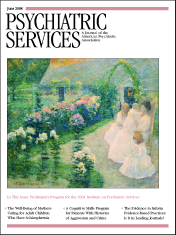Effects of Patient and Health-System Characteristics on Community Tenure of Discharged Psychiatric Inpatients
Abstract
OBJECTIVE: The purpose of this study was to identify the differential effect of patient and health-system characteristics on length of stay in the community among recidivist psychiatric patients. METHODS: Data on demographic and clinical characteristics and mental health service utilization were collected for patients with at least one previous psychiatric hospitalization (N=1,972) who visited a psychiatric emergency department at a university hospital in Leuven, Belgium, between March 2000 and March 2002. Logistic regression analysis was used to compare the characteristics of patients with a short (less than two months), intermediate (two to 12 months), or long (12 months or longer) stay in the community between their last hospital discharge and referral to the psychiatric emergency department. RESULTS: One in three patients visited the psychiatric emergency department within 30 days of discharge from a psychiatric hospitalization, and 43 percent of the patients visited within 60 days of discharge. Patients with a short community stay were more likely to be unemployed and to have had a discharge against medical advice, a short previous hospitalization, no aftercare plan, and a history of two or more previous hospitalizations. Longer community stays were predicted by the presence of a personality disorder. CONCLUSIONS: For patients with a history of psychiatric hospitalization, early psychiatric recidivism may be more highly influenced by health-system characteristics than by the presence of severe mental illness.



